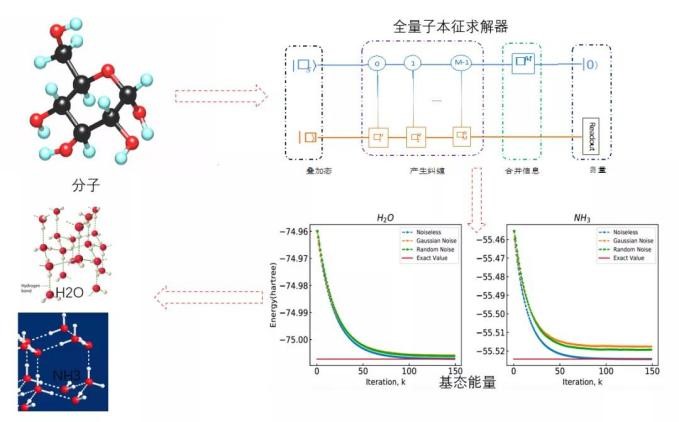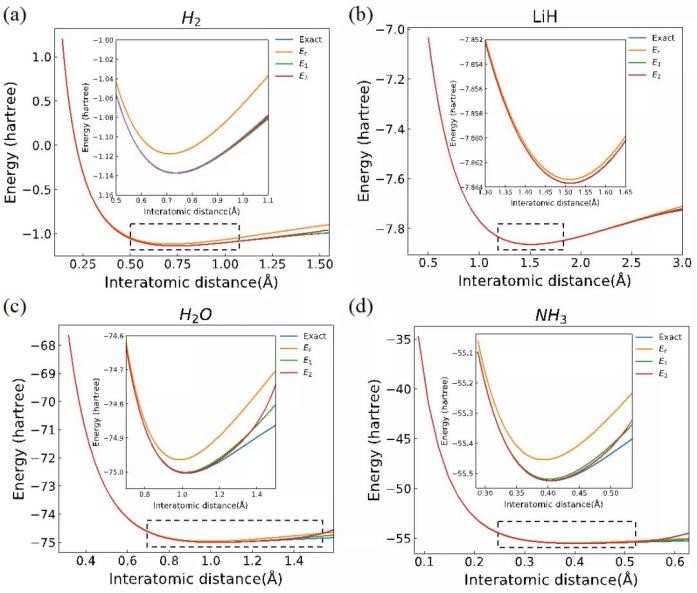Joint Team from Beijing Academy of Quantum Information Sciences and Tsinghua University Achieves New Breakthrough in Simulating Chemical Molecules Using Quantum Computers
2023/11/01

Recently, a collaborative effort between the Beijing Academy of Quantum Information Sciences and Tsinghua University has yielded significant progress in the realm of quantum computing. The joint team, comprised of Dr. Shijie Wei, Dr. Hang Li, and Professor Gui-Lu Long, has made advancements in the development of a Full Quantum Eigensolver (FQE). Their work, titled "A Full Quantum Eigensolver for Quantum Chemistry Simulations," was published in the journal "Research" (Research 2020, DOI: 10.34133/2020/1486935). Through continuous refinement and enhancement, the FQE holds the potential to emerge as a universally applicable platform for quantum chemistry calculations.
Quantum Computing Leading the Future
Research Background
The Past 20 Years
For over the past two decades, we have often heard reports of "successful development of quantum computers," only to be disappointed by demonstrations of devices with just a few quantum bits, incapable of practical computations of value.
2016-2019
This narrative has recently changed, with a significant shift beginning in 2016 when IBM introduced a 5-qubit quantum cloud computing platform. A new era had begun, with major international corporations entering the race to develop quantum computers. In 2019, Google achieved quantum supremacy, showcasing a quantum computer's capability to outperform the world's most powerful classical computers in a specific task. With a 53-qubit quantum computer, they completed a random distribution calculation in just 200 seconds, a task that would take the world's leading supercomputer 10,000 years. This milestone event heralded the arrival of the Noisy Intermediate-Scale Quantum (NISQ) computing era. This "noisy" quantum computer is now a practical tool for solving real-world problems, establishing itself as a continuous focus for future research and applications.
2020
Quantum chemistry simulations applicable to material synthesis and biopharmaceuticals represent one of the most promising areas to achieve quantum advantage in the near future. The computational complexity of simulating chemistry using classical computers is extremely high, as the number of electronic orbitals grows exponentially. Quantum computers, on the other hand, can achieve simulations of large molecules with polynomial-level computational complexity. Efficient quantum chemistry simulations are expected to play a pivotal role in fields such as biopharmaceuticals, new materials, energy, and high-temperature superconductivity. The development of efficient quantum algorithms is essential for realizing efficient quantum simulations.
February 23, 2020
On February 23, 2020, Research published a work titled "A Full Quantum Eigensolver for Quantum Chemistry Simulations" (Research, 2020, 1486935, DOI: 10.34133/2020/1486935) by Dr. Shijie Wei, Hang Li, and Professor Gui-Lu Long, a collaborative team from Beijing Academy of Quantum Information Sciences and Tsinghua University. This full quantum eigensolver employs quantum algorithms to compute molecular ground-state energies and their corresponding electronic structures on quantum computers. Remarkably, it not only works on existing noisy quantum computers such as those developed by IBM and Google but also naturally extends to operate on larger-scale fault-tolerant quantum computers in the future.
Current Status and Prospects
The full quantum eigensolver designed by the team from Beijing Academy of Quantum Information Sciences and Tsinghua University utilizes a quantum gradient descent algorithm. They map the second-quantized fermionic Hamiltonian to a qubit representation Hamiltonian in the Hilbert space, and apply a quantum gradient descent algorithm to determine the ground-state energy and wavefunction. Specifically, within a quantum computing system, they set an appropriate quantum initial state, employ the constructed quantum algorithm for corresponding dynamic evolution, iteratively converge to the ground state, and ultimately measure the quantum state to obtain the required information. Figure 1 illustrates the process of determining the ground-state energy of a molecule. Following preliminary preparations, pertinent software computes the molecular Hamiltonian in the Hilbert space. A specific initial state is employed as input, and quantum logic gate operations are executed using the molecular Hamiltonian to perform computations. Ultimately, measurement results yield information about the molecular ground-state energy and wave function.Finding the most stable molecular structure presents a formidable challenge in quantum chemistry, demanding extensive computational efforts. However, the Full Quantum Eigensolver (FQE) has proven its capabilities in this aspect. By altering the distances between atoms within the molecule, the FQE is capable of ascertaining the lowest-energy state, consequently deriving the molecule's most stable configuration. Figure 2 showcases the process of solving for the stable structures of several molecules.

"Figure 1: Process of Fully Quantum Eigensolver (FQE) calculating the ground-state energy of a molecule."
The term “Full” in “Fully Quantum Eigensolver, FQE)” implies that all computations performed by the FQE are carried out on a quantum computer, whereas other eigensolvers require constant conversions between quantum and classical computers to achieve their results. The reason why FQE can perform all calculations on a quantum computer is due to its utilization of the Unitary Operator Linear Combination (LCU) technique proposed by Professor Gui-Lu Long in 2002 (Gui-Lu Long. "General quantum interference principle and duality computer." Comm Theor Phys 45(5) (2006): 825; SPIE conference on “Fluctuations and Noise in Photonics and Quantum Optics” in 2002). LCU enables addition, subtraction, multiplication, and division operations of unitary operators, whereas previous quantum computing models by Benioff, Feynman, and Deutsch only allowed multiplication and division operations for unitary operators. Long's LCU breakthrough transcended this limitation, providing a new avenue for quantum algorithm design. This method was also adopted by a joint team from China, the UK, and Australia including Qiang X, Zhou X, Wang J, and others. They utilized LCU as the architecture for a quantum computer and developed the world's first universal integrated photonic quantum computing chip [Qiang X, Zhou X, Wang J, et al. Large-scale silicon quantum photonics implementing arbitrary two-qubit processing. Nature Photonics, 2018, 12(9): 534-539].
The era of noisy quantum computing has arrived, marking the beginning of quantum computing applications. With the continuous advancement of quantum computer hardware, improvements in the scale, accuracy, and speed of computations are expected, making research in quantum computing applications the norm. Currently, the authors of FQE are programming it using common quantum computing languages like IBM's Qiskit and Huawei's HiQ, embedding FQE into quantum programming languages to create an integrated general quantum computing platform. This platform aims to handle everything from inputting molecular information to quantum processor calculations and providing feedback to the operator.
FQE operates entirely on quantum computers, allowing calculations not only on current 53-qubit IBM and Google noisy quantum computers but also on future large-scale fault-tolerant quantum computers. With further development and refinement, FQE holds the potential to become a widely used general quantum chemistry computation platform, similar to the Gauss program extensively used on classical computers today.

"Figure 2: Using (a) hydrogen, (b) lithium hydride, (c) water molecule, and (d) ammonia molecule as examples, determining the most stable molecular structures by varying the distances between atoms."
Author Profiles:

Professor Gui-Lu Long: A distinguished professor at Tsinghua University, a fellow of the American Physical Society and the Institute of Physics (UK), known for his contributions in quantum communication and computation research. He introduced the concept of quantum secure direct communication, which ranks among the top three significant theories in quantum secure communication internationally. He also proposed the use of linear combinations of unitary operatorin as duality quantum computation, breaking the constraints of unitary operator products and providing a novel approach to quantum algorithm construction. Professor Long is the originator of the quantum precise search algorithm, earning recognition from quantum computing pioneer Benioff and quantum search algorithm founder Grover. This algorithm is often referred to by scholars worldwide as the Grover-Long algorithm. In 2013, his projects in quantum communication and algorithms were honored with the Prize of the National Natural Science Award.

Dr. Shijie Wei: Got his Ph.D. degree from the Department of Physics at Tsinghua University, currently engaged in postdoctoral research at the Beijing Academy of Quantum Information Sciences. Dr. Wei has utilized the Linear Combination of Unitaries (LCU) method to devise efficient simulation algorithms for open quantum systems, and he has provided the dual quantum computing form of the HHL algorithm. His research primarily centers around the theory of quantum computing, focusing on the creation of novel algorithms.
Link to the paper:https://spj.sciencemag.org/research/2020/1486935/
 中文
中文 Email
Email QCloud
QCloud Log in
Log in
